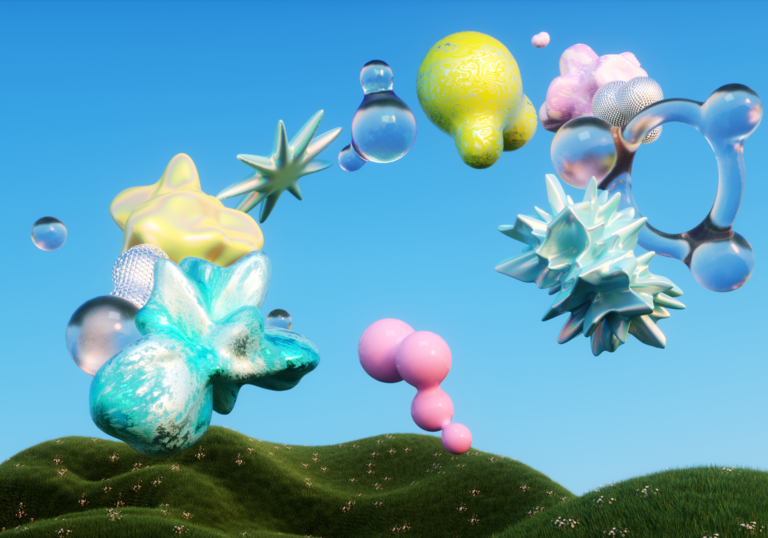Nature has inspired artists since the earliest humans made visual representations of the world around them. But can it inspire us to think in more creative ways about issues such as the climate crisis? Well, now you can see for yourself after artist duo CXC created the Barbican’s first AR effect artwork that everyone can use.
The colourful interactive artwork is inspired by superorganisms – a group of organisms that work together for the common good, such as an ant colony, beehive, or even mycelium (root-like fungal networks).
Featuring abstract shapes that orbit a central point, the AR artwork, called Superorganism, aims to highlight how the organisation of the societies it’s named after can inspire a creative response to the climate crisis.
It also explores the role of randomness in the creative process, acknowledging the impact of chance events on human inspiration and encouraging the use of unpredictability as a tool for experimentation and evolution.
London-based CXC comprises creative/art director, digital artist and educator Christie Morgan (@christiechristie___) and digital artist Chris Golden (@chrisgolden.art). The two explore interconnected ecosystems in online and offline spaces, examining the delicate balance humans face in their wider environments. They use emerging technologies such as CGI, 3D animation, augmented reality, and extended realities to tell these stories.
Morgan says: ‘We’re interested in synthetic reality and how we can digitally replicate nature. In previous work, we looked at how different pieces of an ecosystem intersect with each other, and what that relationship is.’
For our AR artwork, Superorganism, Morgan and Golden were inspired by an afternoon of public activities and installations organised by ODO (Object, Drama, Organism) Collective (@odocollective). The programme featured conversations, installations, and artworks exploring how superorganisms can help us think differently about our relationship with nature.
‘The workshops were an opportunity for us to hear from experts on things such as mycelial networks,’ says Morgan. ‘They explained that superorganisms have different ways of existing, but simultaneously, they’re made up of thousands of entities working together as one being. That’s an inspiring way of reframing ourselves as humans and made us think about how we interact with other humans and other entities on the planet.’
Morgan says the orbiting nature of CXC’s artwork reflects the concept of a solar system as an ecosystem. ‘It was a nice allegory for organisation and reorganisation; how we can restructure the architectural framework of how we operate as creatives. We used a series of abstract shapes that represent things you find in nature, such as humans, bees, ants, and mycelium, but also technology, and how all those parts interact.
‘Because it’s created in AR, we could make these ideas interactive. What I really like about this is that people using it can become part of the artwork, which creates more of a back-and-forth communication between the artwork and the person experiencing it.’
Golden, whose 3D artworks explore the interconnection to nature and inspire new ways of being, explains how they created the work: ‘The objects all have a texture that’s informed by nature. For example, one is inspired by bees and has a honeycomb texture, which we created using an algorithm that takes the mathematics of nature and applies it to a computer-generated surface.’
Being able to experience the work in a variety of different environments, from the Barbican to the streets or even your own home, is an important part of the work. ‘Ultimately, it’s about involving people in the process in a way that creates links between audience and artist - it’s like we’re all having a conversation together,’ says Golden.
Morgan says the two wanted the artwork to have a sense of randomness ‘because things that happen in the world, and the way we are as humans, often feel random, and we have to embrace that’. She adds: ‘From a creative practitioner’s perspective, it’s important to be experimental and to explore things. We wanted to acknowledge that randomness exists in the universe, and that not everything is structured and thought out in the way we might expect. The AR filter shows the complexity that exists in the real world.’
And, while the artwork can stimulate creative ideas, there’s a wider message at its core, as Golden explains: ‘The idea of the superorganism decentres us as humans and takes our egos out of things. We’re interested in the question of why, as humans, we feel we are the ones that get to define how to make things right. We hope it encourages people to be inspired by the ways that other systems work. What I love about the superorganism is it only works if everyone is on the same page – it can’t work with just a handful of elements; it thrives through collaboration. This is something that I feel strongly about in my own creative work – I enjoy being part of a group working together, rather than being siloed.’
You can access the artwork by following this link https://www.instagram.com/ar/1262315191329645/
Using Augmented Reality to improve the real world

16 May 2023
Meet the creators of our first AR effect artwork, and try it yourself.
